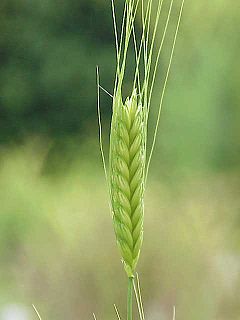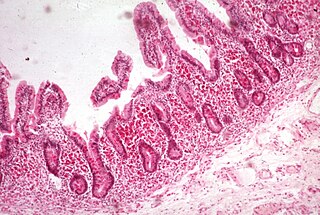
Autism is a developmental disorder characterized by difficulties with social interaction and communication, and by restricted and repetitive behavior. Parents often notice signs during the first three years of their child's life. These signs often develop gradually, though some children with autism experience worsening in their communication and social skills after reaching developmental milestones at a normal pace.

Gluten is a group of proteins, called prolamins and glutelins, which occur with starch in the endosperm of various cereal grains. This protein complex supplies 75–85% of the total protein in bread wheat. It is found in related wheat species and hybrids,, barley, rye, and oats, as well as products derived from these grains, such as breads and malts.

Coeliac disease or celiac disease is a long-term autoimmune disorder that primarily affects the small intestine. Classic symptoms include gastrointestinal problems such as chronic diarrhoea, abdominal distention, malabsorption, loss of appetite and among children failure to grow normally. This often begins between six months and two years of age. Non-classic symptoms are more common, especially in people older than two years. There may be mild or absent gastrointestinal symptoms, a wide number of symptoms involving any part of the body or no obvious symptoms. Coeliac disease was first described in childhood; however, it may develop at any age. It is associated with other autoimmune diseases, such as diabetes mellitus type 1 and thyroiditis, among others.
Gluten-free casein-free diet, also known as gluten-free dairy-free diet, is a diet that does not include the proteins gluten, and casein.

A gluten-free diet (GFD) is a diet that strictly excludes gluten, which is a mixture of proteins found in wheat, as well as barley, rye, and oats. The inclusion of oats in a gluten-free diet remains controversial, and may depend on the oat cultivar and the frequent cross-contamination with other gluten-containing cereals.

Malabsorption is a state arising from abnormality in absorption of food nutrients across the gastrointestinal (GI) tract. Impairment can be of single or multiple nutrients depending on the abnormality. This may lead to malnutrition and a variety of anaemias.
Gluten exorphins are a group of opioid peptides formed during digestion of the gluten protein. It has been hypothesized that people with autism and schizophrenia have abnormal leakage from the gut of these compounds, which then pass into the brain and disrupt brain function, a process collectively known as the opioid excess theory or a part of leaky gut syndrome. This is partly the basis for the gluten-free, casein-free diet. The medical evidence is mixed. Two clinical studies of autism patients who followed this diet found no benefit. Another study found a benefit. Another study suggested the diet may present a greater risk to brain development.
The following outline is provided as an overview of and topical guide to autism:
Leaky gut syndrome is a hypothetical, medically unrecognized condition.

Many causes of autism have been proposed, but understanding of the theory of causation of autism and the other autism spectrum disorders (ASD) is incomplete. Research indicates that genetic factors predominate. The heritability of autism, however, is complex, and it is typically unclear which genes are involved. In rare cases, autism is associated with agents that cause birth defects. Many other causes have been proposed, such as childhood immunizations, but numerous epidemiological studies have shown no scientific evidence supporting any link between vaccinations and autism.
Intestinal permeability is a term describing the control of material passing from inside the gastrointestinal tract through the cells lining the gut wall, into the rest of the body. The intestine normally exhibits some permeability, which allows nutrients to pass through the gut, while also maintaining a barrier function to keep potentially harmful substances from leaving the intestine and migrating to the body more widely. In a healthy human intestine, small particles can migrate through tight junction claudin pore pathways, and particles up to 10–15 Å can transit through the paracellular space uptake route.
The specific carbohydrate diet (SCD) is a diet originally created to manage celiac disease; it limits the use of complex carbohydrates. Monosaccharides are allowed, and various foods including fish, aged cheese and honey are included. Prohibited foods include cereal grains, potatoes and lactose-containing dairy products. It is a gluten-free diet since no grains are permitted.

Wheat allergy is an allergy to wheat which typically presents itself as a food allergy, but can also be a contact allergy resulting from occupational exposure. Like all allergies, wheat allergy involves immunoglobulin E and mast cell response. Typically the allergy is limited to the seed storage proteins of wheat. Some reactions are restricted to wheat proteins, while others can react across many varieties of seeds and other plant tissues. Wheat allergy is rare. Prevalence in adults was found to be 0.21% in a 2012 study in Japan.

Gluten-related disorders is the term for the diseases triggered by gluten, including celiac disease (CD), non-celiac gluten sensitivity (NCGS), gluten ataxia, dermatitis herpetiformis (DH) and wheat allergy. The umbrella category has also been referred to as gluten intolerance, though a multi-disciplinary physician-led study, based in part on the 2011 International Coeliac Disease Symposium, concluded that the use of this term should be avoided due to a lack of specificity.
Alternative therapies for developmental and learning disabilities include a range of practices used in the treatment of dyslexia, ADHD, autism spectrum disorders, Down syndrome and other developmental and learning disabilities. Treatments include changes in diet, dietary supplements, biofeedback, chelation therapy, homeopathy, massage and yoga. These therapies generally rely on theories that have little scientific basis, lacking well-controlled, large, randomized trials to demonstrate safety and efficacy; small trials that have reported beneficial effects can be generally explained by the ordinary waxing and waning of the underlying conditions.
Oat sensitivity represents a sensitivity to the proteins found in oats, Avena sativa. Sensitivity to oats can manifest as a result of allergy to oat seed storage proteins either inhaled or ingested. A more complex condition affects individuals who have gluten-sensitive enteropathy in which there is an autoimmune response to avenin, the glutinous protein in oats similar to the gluten within wheat. Sensitivity to oat foods can also result from their frequent contamination by wheat, barley, or rye particles.
Paul Shattock is a British autism researcher and scientific consultant to the charity Education and Services for People with Autism, of which he is also the founder. He was formerly the director of the Autism Research Unit at the University of Sunderland. He is well known for his disputed research into dietary therapy and autism, having claimed that autistic children may have a "leaky gut" which allows certain peptides to enter the bloodstream, and claimed that they excrete unusually high levels thereof. As a result of this speculation, he has promoted the use of a gluten-free, casein-free diet to ameliorate the symptoms of autism, a theory he developed along with Kalle Reichelt. In addition, he has claimed that a protein found in milk may play a role in the etiology of autism. He is also the former president of the World Autism Organization.
The opioid excess theory is a theory which postulates that autism is the result of a metabolic disorder in which opioid peptides produced through metabolism of gluten and casein pass through an abnormally permeable intestinal membrane and then proceed to exert an effect on neurotransmission through binding with opioid receptors. It is believed by advocates of this hypothesis that autistic children are unusually sensitive to gluten, which results in small bowel inflammation in these children, which in turn allows these opioid peptides to enter the brain.
Non-celiac gluten sensitivity (NCGS) or gluten sensitivity is defined as "a clinical entity induced by the ingestion of gluten leading to intestinal and/or extraintestinal symptoms that improve once the gluten-containing foodstuff is removed from the diet, and celiac disease and wheat allergy have been excluded".
The gluten challenge test is a medical test in which gluten-containing foods are consumed and (re-)occurrence of symptoms is observed afterwards to determine whether and how much a person reacts to these foods. The test may be performed in people with suspected gluten-related disorders in very specific occasions and under medical supervision, for example in people who had started a gluten-free diet without performing duodenal biopsy.








